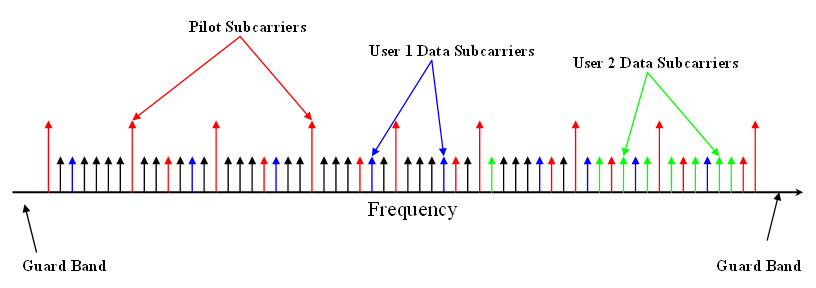|
802.11ax
Wi-Fi 6, or IEEE 802.11ax, is an IEEE standard from the Wi-Fi Alliance, for wireless networks (WLANs). It operates in the 2.4 GHz and 5 GHz bands, with an extended version, Wi-Fi 6E, that adds the 6 GHz band. It is an upgrade from Wi-Fi 5 ( IEEE 802.11ac), with improvements for better performance in crowded places. Wi-Fi 6 covers frequencies in license-exempt bands between 1 and 7.125 GHz, including the commonly used 2.4 GHz and 5 GHz, as well as the broader 6 GHz band. This standard aims to boost data speed (throughput-per-area) in crowded places like offices and malls. Though the nominal data rate is only 37% better than 802.11ac, the total network speed increases by 300%, making it more efficient and reducing latency by 75%. The quadrupling of overall throughput is made possible by a higher spectral efficiency. 802.11ax Wi-Fi has a main feature called OFDMA, similar to how cell technology works with . This brings better spectrum use, improved power control to avo ... [...More Info...] [...Related Items...] OR: [Wikipedia] [Google] [Baidu] |
Resource Unit
Resource Unit (RU) is a unit in OFDMA terminology used in 802.11ax WLAN to denote a group of 78.125 kHz bandwidth subcarriers (tones) used in both DownLink (DL) and UpLink (UL) transmissions. With OFDMA, different transmit powers may be applied to different RUs. There are maximum of 9 RUs for 20 MHz bandwidth, 18 in case of 40 MHz and more in case of 80 or 160 MHz bandwidth. The RUs enables an Access Point station to allow WLAN stations to access it simultaneously and efficiently. Description In the older WLAN standard (802.11ac) only single-user station is allowed to transmit ( uplink transmission) at one point in time, although multi-user downlink (DL-MU-MIMO) from AP to Non-AP stations has been supported through MIMO beamforming. The more stations active in the network, the longer the stations need to wait before allowed to transmit, hence the overall use of wireless channels is inefficient. 802.11ax WLAN is the first WLAN standard to use OFDMA to ... [...More Info...] [...Related Items...] OR: [Wikipedia] [Google] [Baidu] |
Wi-Fi 6 Logo
Wi-Fi () is a family of wireless network protocols based on the IEEE 802.11 family of standards, which are commonly used for Wireless LAN, local area networking of devices and Internet access, allowing nearby digital devices to exchange data by radio waves. These are the most widely used computer networks, used globally in small office/home office, home and small office networks to link devices and to provide Internet access with wireless routers and wireless access points in public places such as coffee shops, restaurants, hotels, libraries, and airports. ''Wi-Fi'' is a trademark of the Wi-Fi Alliance, which restricts the use of the term "''Wi-Fi Certified''" to products that successfully complete Interoperability Solutions for European Public Administrations, interoperability certification testing. Non-compliant hardware is simply referred to as WLAN, and it may or may not work with "''Wi-Fi Certified''" devices. the Wi-Fi Alliance consisted of more than 800 companies from ar ... [...More Info...] [...Related Items...] OR: [Wikipedia] [Google] [Baidu] |
List Of WLAN Channels
Wireless LAN (WLAN) channels are frequently accessed using IEEE 802.11 protocols. The 802.11 standard provides several radio frequency bands for use in Wi-Fi communications, each divided into a multitude of channels numbered at 5 MHz spacing (except in the 45/60 GHz band, where they are 0.54/1.08/2.16 GHz apart) between the centre frequency of the channel. The standards allow for channels to be bonded together into wider channels for faster throughput. 860/900 MHz (802.11ah) 802.11ah operates in sub-gigahertz unlicensed bands. Each world region supports different sub-bands, and the channels number depends on the starting frequency on the sub-band it belongs to. Therefore there is no global channels numbering plan, and the channels numbers are incompatible between world regions (and even between sub-bands of a same world region). The following sub-bands are defined in the 802.11ah specifications: 2.4 GHz (802.11b/g/n/ax/be) 14 channels are designated in t ... [...More Info...] [...Related Items...] OR: [Wikipedia] [Google] [Baidu] |
Subcarrier Spacing
In telecommunications, orthogonal frequency-division multiplexing (OFDM) is a type of digital transmission used in digital modulation for encoding digital (binary) data on multiple carrier frequencies. OFDM has developed into a popular scheme for wideband digital communication, used in applications such as digital television and audio broadcasting, DSL internet access, wireless networks, power line networks, and 4G/ 5G mobile communications. OFDM is a frequency-division multiplexing (FDM) scheme that was introduced by Robert W. Chang of Bell Labs in 1966. In OFDM, the incoming bitstream representing the data to be sent is divided into multiple streams. Multiple closely spaced orthogonal subcarrier signals with overlapping spectra are transmitted, with each carrier modulated with bits from the incoming stream so multiple bits are being transmitted in parallel. [...More Info...] [...Related Items...] OR: [Wikipedia] [Google] [Baidu] |
Spectral Efficiency
Spectral efficiency, spectrum efficiency or bandwidth efficiency refers to the information rate that can be transmitted over a given bandwidth in a specific communication system. It is a measure of how efficiently a limited frequency spectrum is utilized by the physical layer protocol, and sometimes by the medium access control (the channel access protocol). Guowang Miao, Jens Zander, Ki Won Sung, and Ben Slimane, Fundamentals of Mobile Data Networks, Cambridge University Press, , 2016. Link spectral efficiency The link spectral efficiency of a digital communication system is measured in '' bit/ s/ Hz'', or, less frequently but unambiguously, in ''(bit/s)/Hz''. It is the net bit rate (useful information rate excluding error-correcting codes) or maximum throughput divided by the bandwidth in hertz of a communication channel or a data link. Alternatively, the spectral efficiency may be measured in ''bit/symbol'', which is equivalent to ''bits per channel use'' (''bpcu''), i ... [...More Info...] [...Related Items...] OR: [Wikipedia] [Google] [Baidu] |
Guard Interval
In telecommunications Telecommunication, often used in its plural form or abbreviated as telecom, is the transmission of information over a distance using electronic means, typically through cables, radio waves, or other communication technologies. These means of ..., guard intervals are used to ensure that distinct transmissions do not interfere with one another, or otherwise cause overlapping transmissions. These transmissions may belong to different users (as in TDMA) or to the same user (as in OFDM). The purpose of the guard interval is to introduce immunity to propagation delays, echoes and reflections, to which digital data is normally very sensitive. Use in digital communications systems In OFDM, the beginning of each symbol is preceded by a guard interval. As long as the echoes fall within this interval, they will not affect the receiver's ability to safely decode the actual data, as data is only interpreted outside the guard interval. In TDMA, each user's ... [...More Info...] [...Related Items...] OR: [Wikipedia] [Google] [Baidu] |
OFDMA
Orthogonal frequency-division multiple access (OFDMA) is a multi-user version of the popular orthogonal frequency-division multiplexing (OFDM) digital modulation scheme. Multiple access is achieved in OFDMA by assigning subsets of subcarriers to individual users. This allows simultaneous low-data-rate transmission from several users. Comparisons OFDMA is often compared to the combination of OFDM with statistical time-division multiplexing. The advantages and disadvantages summarized below are further discussed in the Characteristics and principles of operation section. See also the list of OFDM key features. Advantages * Allows simultaneous low-data-rate transmission from several users. * Pulsed carrier can be avoided. * Lower maximal transmission power for low-data-rate users * Shorter delay and constant delay * Contention-based multiple access (collision avoidance) is simplified. * Further improves OFDM robustness to fading and interference * Combat narrow-band interfe ... [...More Info...] [...Related Items...] OR: [Wikipedia] [Google] [Baidu] |
SIFS
Short Interframe Space (SIFS), is the amount of time in microseconds required for a wireless interface to process a received frame and to respond with a response frame. It is the difference in time between the first symbol of the response frame in the air and the last symbol of the received frame in the air. A SIFS time consists of the delay in receiver RF, PLCP delay and the MAC processing delay, which depends on the physical layer used. In IEEE 802.11 networks, SIFS is the interframe spacing prior to transmission of an acknowledgment, a Clear To Send (CTS) frame, a block ack frame that is an immediate response to either a block ack request frame or an A-MPDU, the second or subsequent MPDU of a fragment burst, a station responding to any polling a by point coordination function and during contention free periods of point coordination function. Implications for Software Radio Because most Software-Defined Radios use a host computer for processing, the SIFS impose ... [...More Info...] [...Related Items...] OR: [Wikipedia] [Google] [Baidu] |
WPA3
Wi-Fi Protected Access (WPA) (Wireless Protected Access), Wi-Fi Protected Access 2 (WPA2), and Wi-Fi Protected Access 3 (WPA3) are the three security certification programs developed after 2000 by the Wi-Fi Alliance to secure wireless computer networks. The Alliance defined these in response to serious weaknesses researchers had found in the previous system, Wired Equivalent Privacy (WEP). WPA (sometimes referred to as the TKIP standard) became available in 2003. The Wi-Fi Alliance intended it as an intermediate measure in anticipation of the availability of the more secure and complex WPA2, which became available in 2004 and is a common shorthand for the full IEEE 802.11i (or IEEE 802.11i-2004) standard. In January 2018, the Wi-Fi Alliance announced the release of WPA3, which has several security improvements over WPA2. As of 2023, most computers that connect to a wireless network have support for using WPA, WPA2, or WPA3. All versions thereof, at least as implemented throu ... [...More Info...] [...Related Items...] OR: [Wikipedia] [Google] [Baidu] |
Uplink
In a telecommunications network, a link is a communication channel that connects two or more devices for the purpose of data transmission. The link may be a dedicated physical link or a virtual circuit that uses one or more physical links or shares a physical link with other telecommunications links. A telecommunications link is generally based on one of several types of information transmission paths such as those provided by communication satellites, terrestrial radio communications infrastructure and computer networks to connect two or more points. The term ''link'' is widely used in computer networking to refer to the communications facilities that connect nodes of a network. Sometimes the communications facilities that provide the communication channel that constitutes a link are also included in the definition of ''link''. Types Point-to-point A point-to-point link is a dedicated link that connects exactly two communication facilities (e.g., two nodes of a network, ... [...More Info...] [...Related Items...] OR: [Wikipedia] [Google] [Baidu] |
Multi-user MIMO
Multi-user MIMO (MU-MIMO) is a set of multiple-input and multiple-output (MIMO) technologies for multipath wireless communication, in which multiple users or terminals, each radioing over one or more antennas, communicate with one another. In contrast, single-user MIMO (SU-MIMO) involves a single multi-antenna-equipped user or terminal communicating with precisely one other similarly equipped node. Analogous to how OFDMA adds multiple-access capability to OFDM in the cellular-communications realm, MU-MIMO adds multiple-user capability to MIMO in the wireless realm. SDMA,N. JindalMIMO Broadcast Channels with Finite Rate Feedback IEEE Transactions on Information Theory, vol. 52, no. 11, pp. 5045–5059, 2006.D. Gesbert, M. Kountouris, R.W. Heath Jr., C.-B. Chae, and T. SälzerShifting the MIMO Paradigm IEEE Signal Processing Magazine, vol. 24, no. 5, pp. 36-46, 2007.R. Tweg, R. Alpert, H. Leizerovich, A. Steiner, E. Levitan, E. Offir-Arad, A.B. Guy, B. Zickel, A. Aviram, A. Friema ... [...More Info...] [...Related Items...] OR: [Wikipedia] [Google] [Baidu] |




